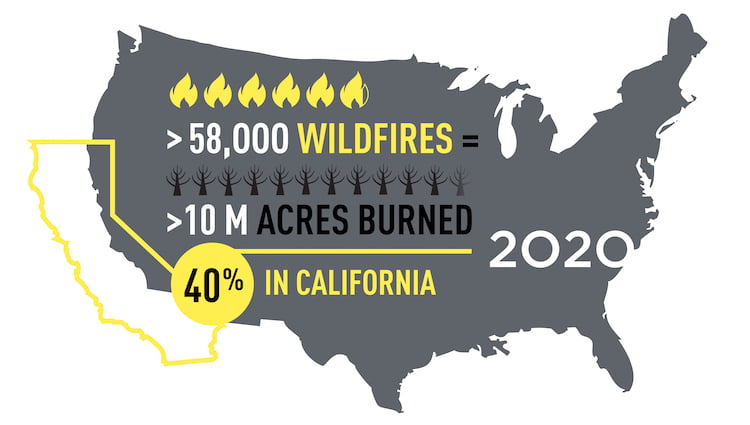
Wildfires have been rampant for the past several years, ravaging parts of California, Colorado, Oregon, and Washington. In 2018 alone, 8.7 million acres of land were burned in wildfires. Why do these wildfires seem to get more intense and frequent with time? Hot, dry conditions are often pointed out as the main reason wildfires start. However, they do not automatically guarantee a fire will break out—something must create the spark and start the fire. In some parts of the country, like Alaska, most fires are ignited by lightning. In other areas, like California, most fires are started by humans.
Knowing how wildfires start in your region and if your area is particularly vulnerable can help you better prepare. Wildfires can be started in various ways, but the two leading causes are natural and human.
Natural Causes of Wildfires
Natural wildfires are almost always caused by lightning, though in rare instances, volcanoes, meteors, and coal seams can also cause wildfires. Lightning produces enough heat to ignite leaves, trees, or other organic materials, especially in dry conditions.
Lightning can be especially dangerous because it can cause a wildfire anywhere, even in hard-to-access areas. It is also usually accompanied by strong thunderstorm winds that can turn a spark into a raging fire.
Natural conditions that make it more likely for a wildfire to start also increase the risk. The United States Geological Society says climate change could cause more frequent and intense wildfires, although a direct relationship hasn’t been determined. However, researchers have found that warmer summers result in more wildfires. The consensus is that wildfire frequency will increase with climate change.
Human Causes of Wildfires
Nearly 85 percent of wildfires are caused by people. Human-caused wildfires can be classified into accidental fires and incendiary fires. Some unintentional causes include unattended campfires, smoldering cigarettes, debris burning, sparks from equipment, fireworks, and in recent years, gender reveal parties.
Incendiary causes include arson and illegal or unauthorized burning, leading to extensive property damage. According to a study by the Forestry Sciences Laboratory, over 0.5 million fires are set by arsonists each year, resulting in over $3 billion in damages. Knowing how to extinguish a fire is an essential skill that may help prevent a wildfire from starting in your area.
Data from the National Interagency Fire Center shows that the number of annual wildfires has decreased slightly over the last 30 years, but the number of acres impacted annually has increased.
In 2020, more than 58,000 wildfires burned a record-setting 10+ million acres, nearly 40% of these acres in California. California has so many wildfires due to the dry, windy, and hot weather conditions that provide the perfect conditions for a wildfire to start. Combined with natural or human-made causes, such as sparks from equipment, overhead power lines, or arsonists, this can lead to devastating wildfires. In addition, wildfires are common in forested areas, so California and other areas with dense forests may be more at risk.

While most of these happen during wildfire season, they can start whenever conditions are favorable. Fortunately, the Forest Service has resources to forecast potential wildfire activity and a strategy to stop it quickly when it occurs.
How Can I Protect My Property From Wildfires?
While wildfires are hard to predict and control, there are some preventive steps that you can take. Just a few of the ways you can protect your property from wildfires include:
- Removing dead vegetation from trees and bushes close to your home. Dead vegetation provides the perfect fuel for a fire to spread quickly. Removing it will help decrease the chances that a fire will spread to your property.
- Moving firewood away from home. Having firewood or other combustible materials near your home increases the risk of fire spreading to your home.
- Clearing out gutters of twigs and leaves. Wildfires spread quickly, and having twigs or leaves in your gutter provides the perfect fuel for the fire to spread rapidly and close to your home’s walls.
- Ensuring your home’s roof uses class A fire-rating materials. While they will not protect you against all fires, they will last 2 to 4 hours before ignition and can withstand fire longer than other roof types.
Recover From Wildfire Damage To Your Property
Wildfires spread fast and can cause significant damage to your home and other property. It can lead to severe damage to your property and lead to destruction of your foundation. In addition, it can also lead to additional damage throughout your home, including damage to carpets, furniture, walls, roofs, or windows, odor damage to your home, or soot which will need to be removed.
If you do experience wildfire damage to your home or business, ServiceMaster Restore is ready to help. We’ll review your property and work with you to restore what can be restored, keeping you informed throughout each step. We have more than 850 locations across the United States that are locally owned and operated.
Our team is backed by over 65 years of experience, and our restoration experts will help you get back to normal as quickly as possible. Call 1-800-RESPOND to reach our disaster response center 24 hours a day, 7 days a week, 365 days a year.

